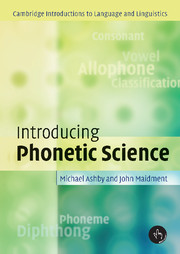9 - Basic phonological concepts
Published online by Cambridge University Press: 05 June 2012
Summary
CHAPTER OUTLINE
In this chapter you will learn: the way that sound differences are used to distinguish words; how similar, noncontrastive sounds can be grouped into phonemes; how sounds form patterns in a language; how to look for patterns in samples of phonetic data; about the grouping of sounds into syllables; differences between languages in permitted sound groupings; about widespread phonological processes in languages; about phonological features and phonological rules.
KEY TERMS
Allophone
Alternation
Assimilation
Coda
Contrast
Distribution
Elision
Environment
Feature
Lenition
Minimal pair
Onset
Phoneme
Phonological process
Rhyme
Rule
Contrast
Imagine a language where all word-initial consonants are voiceless and all consonants elsewhere in a word are voiced. This would mean that in this language a word like [pidag] is possible, but one like [bitak] is impossible. The voicing of a consonant in this language is completely determined by some aspect of the environment of the consonant, in this case the position within a word. It is impossible for this language to use the phonetic distinction between voiced consonants and voiceless ones to distinguish one word from another, even though the language has voiced and voiceless pairs of consonants. We can say that in this language there is no voicing contrast or, equivalently, that voicing of consonants is not contrastive in this language.
In English and in many other languages, voicing is contrastive for consonants. We can demonstrate this with a pair of words like fussy [fʌsi] and fuzzy [fʌzi] in English or a pair in French like choux [∫u] ‘cabbage’ and joue [зu] ‘play’.
- Type
- Chapter
- Information
- Introducing Phonetic Science , pp. 135 - 152Publisher: Cambridge University PressPrint publication year: 2005



